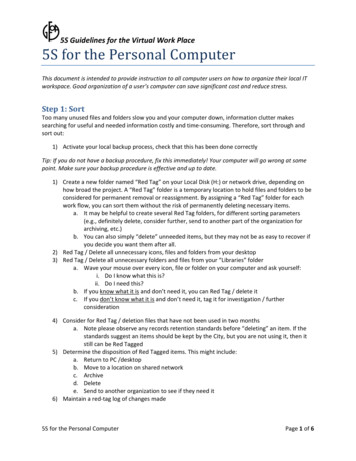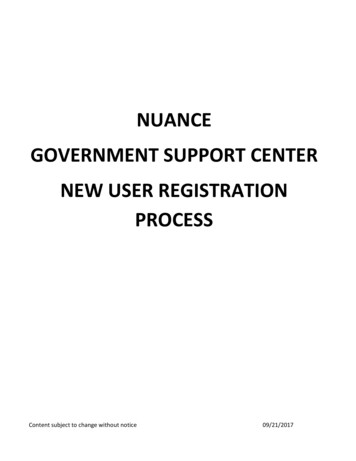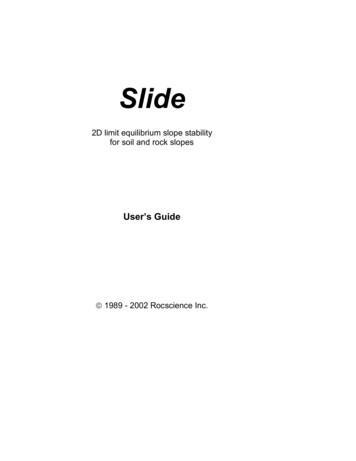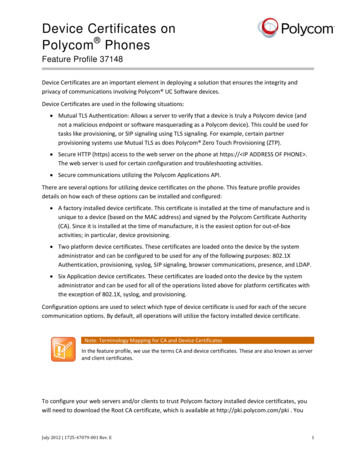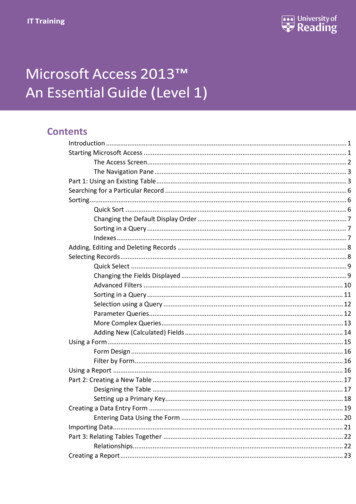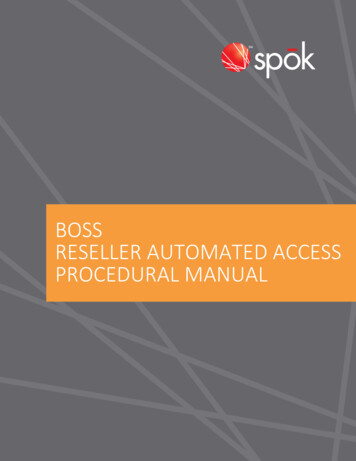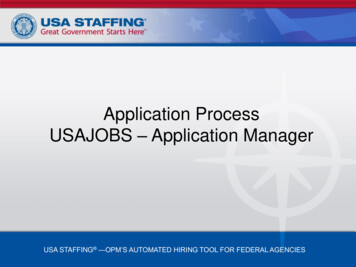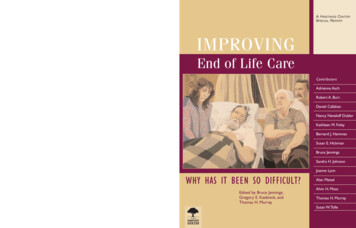
Transcription
THE HASTINGS CENTERhe Hastings Center addresses fundamental ethical issuesin the areas of health, medicine, and the environment asthey affect individuals, communities, and societies. With asmall staff of senior researchers at the Center and drawingupon an internationally renowned group of over 100 electedFellows for their expertise, The Hastings Center pursuesinterdisciplinary research and education that includes boththeory and practice. Founded in 1969 by philosopher DanielCallahan and psychoanalyst Willard Gaylin, The HastingsCenter is the oldest independent, nonpartisan, interdisciplinary research institute of its kind in the world. From its earliest days The Hastings Center has understood that themoral problems arising from rapid advances in medicine andbiology are set within a broad intellectual and social context.The Center’s collaborations with policymakers, in the privateas well as the public sphere, assist them in analyzing the ethical dimensions of their work.TAlso from The Hastings Center Access to Hospice Care:Expanding Boundaries, Overcoming BarriersBy Bruce Jennings, True Tyndes, Carol D’Onofrio, andMary Ann BailyA SPECIAL REPORT PUBLISHED WITH THE MARCH-APRIL2003 HASTINGS CENTER REPORTThis document looks at issues of social justice, access,and public policy in hospice and palliative care. As itexamines the issues from the perspectives of social justice and fairness, it also recommends ways in which thedefinition of hospice can be expanded to include moreAmericans for a longer period of time than simply thedays or months shortly before death.O R D E R I N F O R M AT I O NFor copies of this or other Hastings Center ReportSpecial Reports write or call:Subscription DepartmentThe Hastings Center21 Malcolm Gordon RoadGarrison, NY 10524(845) 424-4040(845) 424-4545 ngscenter.org.I M P R OV I N G E N D O F L I F E C A R E : W H Y H A S I T B E E N S O D I F F I C U LT ?ABOUTA HASTINGS CENTERSPECIAL REPORTIMPROVINGEnd of Life CareContributorsAdrienne AschRobert A. BurtDaniel CallahanNancy Neveloff DublerKathleen M. FoleyBernard J. HammesSusan E. HickmanOn the cover:Bruce JenningsAt Night, Deidre Scherer 2000, from the series Surrounded by Family and Friends, 36 x 48 inches, fabric and thread Photo: Jeff BairdSandra H. JohnsonJoanne Lynn. . . . .T. . H. . .E. . . . .HASTINGS.CENTERWHY HAS IT BEEN SO DIFFICULT?G A R R I S O N , N EW Y O R K10524-5555Edited by Bruce Jennings,Gregory E. Kaebnick, andThomas H. MurrayAlan MeiselAlvin H. MossThomas H. MurraySusan W.Tolle
Authors Adrienne Asch is the newly-appointed Edward and Robin Milstein Professor ofBioethics of Yeshiva University-Wurzweiler School of Social Work. In addition to heryears of writing and teaching in bioethics at Wellesley College and Boston University,she brings policy experience through her work with the New Jersey Commission onLegal and Ethical Problems in the Delivery of Health Care, where she worked onissues of protecting vulnerable patients, determination of death, and health care decision-making at the end of life. Robert A. Burt is Alexander M. Bickel Professor of Law at Yale University. Herecently wrote Death Is That Man Taking Names: Intersections of American Medicine,Law, and Culture (University of California Press, 2002). From 1993 to 2003, he servedon the Advisory Board of the Project on Death in America, Open Society Institute, andfrom 1995 to 1997 was a member of the Institute of Medicine Committee on Careat the End of Life. Daniel Callahan, Director of the International Program at The HastingsCenter, has worked with Center research projects on death since its beginning in1969. He is also the author of The Troubled Dream of Life: In Search of a PeacefulDeath (Georgetown, 2000; second edition). Nancy Neveloff Dubler is the director of the Division of Bioethics,Department of Epidemiology and Population Health, Montefiore Medical Center, andprofessor of epidemiology and population health at the Albert Einstein College ofMedicine. She also directs the Bioethics Consultation Service at Montefiore MedicalCenter (founded in 1978) as a support for analysis of difficult clinical cases presenting ethical issues in the health care setting, using mediation as its process. She iscodirector of the certificate program in bioethics and the medical humanities, conducted jointly by Montefiore Medical Center/Albert Einstein College of Medicine withCardozo Law School of Yeshiva University. Her most recent book is Bioethics Mediation:A Guide to Shaping Shared Solutions, with Carol Liebman (United Hospital Fund,2004). Kathleen M. Foley is an attending neurologist in the Pain and PalliativeCare Service at Memorial Sloan-Kettering Cancer Center. She teaches neurology, neuroscience, and clinical pharmacology at Weill Medical College of Cornell University andholds the Chair of the Society of Memorial Sloan-Kettering Cancer Center in PainResearch. As an expert consultant to the World Health Organization Cancer andPalliative Care Unit and as past director of a WHO Collaborating Center at MemorialSloan Kettering Cancer Center, she chaired three expert committees, resulting in thepublication of three WHO monographs: Cancer Pain Relief (1986), Cancer Pain Reliefand Palliative Care (1990) and Cancer Pain and Palliative Care in Children (1996). Bernard Hammes serves as the director of medical humanities atGundersen Lutheran Medical Foundation and Medical Center. Dr. Hammes has publishednumerous articles on end of life planning, and several private foundations have funded his work. He led the development of the advance care planning programRespecting Choices and is a member of the National POLST (Physician Orders for LifeSustaining Treatment) Paradigm Task Force. Susan Hickman is on faculty at the School of Nursing and School ofMedicine at Oregon Health & Science University (OHSU), where she researches ethicalissues at the end of life and in the conduct of research. She is also a senior scholarin the OHSU Center for Ethics in Health Care. She is a consultant to the OregonPOLST Task Force and a serves on the National POLST Paradigm Task Force. Bruce Jennings is senior research scholar at The Hastings Center and alsoteaches at the Yale University School of Public Health. He served as associate directorof a project that produced the widely cited and influential Guidelines on theTermination of Life-Sustaining Treatment and the Care of the Dying (The HastingsCenter, 1987). He is also cofounder of Decisions Near the End of Life, an educationaland institutional change program on end of life care that has been used in over twohundred hospitals in thirty states. He has served on the boards of directors of boththe National Hospice and Palliative Care Organization and the Hospice and PalliativeCare Association of New York State and has written widely on ethical issues in end oflife, hospice, and palliative care. Sandra H. Johnson holds the Tenet Endowed Chair in Health Care Law andEthics at the School of Law and the Center for Health Care Ethics at Saint LouisUniversity, as well as faculty appointments as professor of law in internal medicine atthe University’s School of Medicine and professor of health care administration at theSchool of Public Health. She directs the Mayday Project on Legal and RegulatoryIssues in Pain Relief at the American Society of Law, Medicine & Ethics and coauthored Health Law – Cases, Materials and Problems (Thomson West, 1987; now in itsfifth ed.). Joanne Lynn is a geriatrician and researcher who has focused upon seriouschronic illness and the end of life. She is senior natural scientist at the RANDCorporation in Arlington, VA. Alan Meisel is professor of law, Dickie, McCamey & Chilcote Professor ofBioethics, and director of the Center for Bioethics and Health Law at the Universityof Pittsburgh. He served on the President’s Commission for the Study of Ethical Issuesin Medicine and Biomedical and Behavioral Research and participated in the authorship of its report, Deciding to Forego Life-Sustaining Treatment. He is the principalauthor of the legal treatise, “The Right to Die: The Law of End-of-LifeDecisionmaking.” Alvin Moss is a professor of medicine and the director of the Center forHealth Ethics and Law at the Robert C. Byrd Health Sciences Center of West VirginiaUniversity. He also serves as executive director of the West Virginia Center for End-ofLife Care which oversees the West Virginia POST (Physician Orders for Scope ofTreatment) Program. He has published numerous articles on end of life care—particularly relating to dialysis patients—and has been awarded foundation grants to support research and public outreach on end of life care. Dr. Moss is a member of theNational POLST Paradigm Task Force. Thomas H. Murray is in his second tour of duty at The Hastings Center,this time as President (earlier, he was a research associate at the Center). He has alongstanding interest in how families face moral challenges. His most recent book isThe Cultures of Caregiving: Conflict and Common Ground among Families, HealthProfessionals, and Policy Makers (Johns Hopkins, 2004), edited with Carol Levine. Otherbooks include The Worth of a Child; Healthcare Ethics and Human Values (Universityof California, 1996); and the Encyclopedia of Ethical, Legal, and Policy Issues inBiotechnology (Wiley, 2000), edited with Maxwell J. Mehlman. Susan Tolle is a professor of general internal medicine and geriatrics atOregon Health & Science University (OHSU) as well as cofounder and director of theUniversity’s Center for Ethics in Health Care and Cornelia Hayes Stevens Chair. Dr.Tolle has participated in two National Institutes of Health studies and has been principle investigator on thirty-nine foundation grants focused on end of life care, withcontinuous funding for two decades. She serves on the Oregon POLST Task Force andthe National POLST Paradigm Task Force.ILLUSTRATION CREDITSDeidre Scherer's fabric and thread images on aging have appeared inmany exhibitions throughout the United States and the world. Sheis also the recipient of a Fine Arts Fellowship from the Open SocietyInstitute's Project on Death in America. For more information, visitwww.dscherer.com.The Robert Pope Foundation was established in 1992 to continuethe significant work started by Robert Pope before his death fromcancer at age 35. A talented artist, he completed a large body ofwork showing the cancer experience from the patient’s perspective.Since his death, this collection of paintings has been shown in 91cities worldwide, including medical clinics such as the Mount SinaiMedical Clinic in New York and the Mayo Clinic in Rochester,Minn. The Robert Pope Foundation also promotes educational,artistic, and health-related programs. For more information, visitwww.robertpopefoundation.org.
Table of Contents2Preface Bruce Jennings5Death:“The Distinguished Thing” Daniel Callahan9The End of Autonomy Robert A. Burt14Living Long in Fragile Health: The New Demographics Shape End of Life Care Joanne Lynn19Conflict and Consensus at the End of Life Nancy Neveloff Dubler26Hope for the Future: Achieving the Original Intent of Advance DirectivesSusan E. Hickman, Bernard J. Hammes, Alvin H. Moss, and Susan W. Tolle31Recognizing Death while Affirming Life:Can End of Life Reform Uphold a Disabled Person’s Interest in Continued Life? Adrienne Asch37Making Room for Dying: End of Life Care in Nursing Homes Sandra H. Johnson42The Past and Future of Palliative Care Kathleen M. Foley47The Role of Litigation in End of Life Care: A Reappraisal Alan Meisel52The Quest to Reform End of Life Care: Rethinking Assumptions and Setting New DirectionsThomas H. Murray and Bruce Jennings58Selected References60End of Life Care Resources
Prefacet the time of the Karen Ann Quinlan case in1975, the law and ethics of forgoing life-sustaining treatment were terra incognita. By 1990, theNancy Beth Cruzan case, the federal Patient Self-Determination Act, and court rulings and statutes in all fiftystates had created a widely accepted framework for decision-making near the end of life. Establishing this framework is one of the great accomplishments in bioethics.Or so goes one common story. Expanded a little, thestory goes like this: Thirty years ago, awareness began togrow that the experience of dying (for the individual, forthe family, and often for health caregivers) was often ahorror. Sentiment began to grow behind a movement toimprove end of life care, and this reform movement wasbased on the belief that the horror of death was avoidablebecause it does not reside in dying or death per se, but ina poorly managed dying. What needed to be done, the reformers saw, was to look death in the face and wrest control over dying from doctors and hospitals, with theirpowerful but mindless drugs and machines—virtual loosecannons that could be as burdensome for some as theywere beneficial to others. If lack of control, the technological imperative, and unrelieved pain and suffering arewhat make dying fearful, then the key to improving endof life care is twofold: First, we should enlist the law toempower persons to dictate the terms of their own medical care at the end of life (via constitutional rights andlegally authorized advance directives). Second, we shouldenlist medicine to improve its skill at treating pain andsuffering (financing for hospice and professional education in palliative care). If we could do these two things(the reformers hoped and believed), ordinary people andtheir families—the intended beneficiaries of all thiswork—would embrace the reforms with open arms, insiston making their own medical decisions at life’s end, andcomplete advance directives. By 1990, although work remained to be done to bring this agenda to fruition, theagenda itself, at least, was settled.This story is partly true, and some of the reformers’ vision has been realized. Today people have much moreABruce Jennings, “Preface,’” Improving End of Life Care: Why Has It Been SoDifficult? Hastings Center Report Special Report 35, no. 6 (2005), S2-S4.S2control of their medical care at the end of life, the technological imperative has been bridled to some extent, andpalliative care is taken more seriously in the medical mainstream. Over 700,000 people who die each year receivehospice services for at least a short period of time beforedeath; and roughly three-quarters of all deaths in hospitalsnow come after some explicit decision has been made toforgo the use of some type of potentially life-prolongingintervention. Many people are fortunate enough to diewith pain kept to a minimum, surrounded by the peoplethey love, in a setting attentive to their spiritual, emotional, and physical needs. That is progress.But while the story is partly true, it is altogether toofacile and simplistic. What progress has been made is nowin danger of being undone. The framework of principlesfor legitimate decision-making at the end of life built bythe courts, the legislatures, and in the professional andethical literature has not been embraced—indeed, it hasbeen rejected, at least in large part—by increasingly powerful and vocal minorities; and political support for thisframework, as well as its intellectual justification, seems tobe eroding. This is a critical problem. It points to flaws inboth our concepts and our institutions. Important assumptions—about autonomy, quality of life, trust, familydynamics, and the motivations of professionals andlaypeople—need to be rethought. Our systems of decision-making and care delivery near the end of life need tobe redesigned.The topic of end of life care came into its own duringthe 1990s. The decade began with the Cruzan case, theSupreme Court’s first landmark ruling on end of life care,in which the Court affirmed the constitutional right torefuse life-sustaining medical treatment. This was quicklyfollowed by passage of the federal Patient Self-Determination Act, and of durable power of attorney for health carestatutes in many states, all stressing the importance ofconsidering each person’s preferences about end of lifecare in advance. Public education efforts to encourage theuse of advance directives sprang up nationwide.In the mid-1990s, the Study to Understand Prognosesand Preferences for Outcomes and Risks of Treatments(SUPPORT) rigorously documented the alarming extentto which aggressive life-prolonging measures were stillNovember-December 2005/HASTINGS CENTER REPORT
being used in situations where they were either medicallyfutile, unwanted by patients and families, or both. Evenconcerted efforts to improve communication betweenphysicians and dying patients did not stem the technological momentum of life-prolonging treatments in thecountry’s major medical centers. Moreover, a large proportion of families reported that the patient had spent thelast two or three days of life in severe, unrelieved pain. Aprecursor to this supplement, Dying Well in the Hospital:The Lessons of SUPPORT, which was published in theHastings Center Report exactly ten years ago, contains athorough discussion of this important research.Growing fears of losing control of care at the end oflife, of becoming dependent on machines, of being anemotional and financial burden to one’s family, and ofsuffering due to inadequate treatment of pain and othersymptoms—all these fears and more led to a growinggrassroots movement in the late 1990s to legalize “physician assisted suicide” (PAS), or what some prefer to call“physician aid in dying.” The situation was dramatized bythe public defiance of the law by Dr. Jack Kevorkian, thecontroversial Oregon referendum that legalized PAS inthat state, and the Federal Appeals Court rulings in theSecond and Ninth Circuits that temporarily struck downexisting state laws against PAS before the Supreme Courtoverturned those appellate rulings in 1997. But while itrefused to strike down existing state laws prohibiting PAS,the Court also decided not to interfere with the Oregonlaw permitting it, and it left the constitutional door opento other states to change their laws on PAS as they saw fit.Controversy over PAS in Oregon still continues, however,as federal officials in the Bush administration have soughtto undermine it through regulatory sanctions againstphysicians. Meanwhile, referenda to legalize PAS havefailed at the ballot box in some other states. Dr. Kevorkianis currently serving a prison sentence.Even as these controversies monopolized most mediaattention, a less contentious but arguably more significantlong-term educational and institutional effort was underway, led by several groups seeking to improve end of lifecare and to address the concerns of the general public.Chief among them was hospice, which first appeared inthe United States in the 1970s but which became morewidely known and utilized in the 1990s. Efforts by hospitals and community groups to educate consumers concerning the use of advance directives also became widespread. Some educational programs have been aimed athealth care professionals, whose formal training had oftennot included death and dying or palliative care. Amongthese programs is “Decisions Near the End of Life,” created by the Education Development Center and The Hastings Center with support from the W.K. Kellogg Foundation and used by approximately two hundred hospitals inthirty states. Other educational programs focused on con-sumers and communities were sponsored by groups suchas the American Association of Retired Persons and various state-based coalitions and consortia, including the socalled community health decisions groups.The health care professions themselves have also paidgrowing attention to improving the standard of practicein pain management and palliative care. A landmark Institute of Medicine study, Approaching Death, proposedimprovements in the quality of palliative care. As the essayin this collection by Kathleen Foley reminds us, specialistsin this area have long argued that basic medical educationand general skill and knowledge within medicine are notsufficient to meet patient needs; pain has been systematically and persistently undertreated in mainstream American health care. New curricula for medical and nursingeducation have been developed and implemented; amajor educational program of the American Medical Association, known as EPEC, trains physicians throughoutthe country in order to encourage better advance careplanning with patients and palliative care skills, and theAmerican Nurse’s Association offers a parallel programcalled ELNEC. Other more specialized educational programs have followed suit, such as EPEC-O, sponsored bythe American Society of Clinical Oncology for oncologists, and APPEAL, sponsored by the Institute to ImproveEnd of Life Care for African Americans. In addition, CorePrincipals of Palliative Care have been adopted by nineteen national professional organizations to include in theirteaching programs. The Veterans’ Healthcare Administration has developed palliative care teams and leaders, making palliative care integral into its health care system. Andthe Center to Advance Palliative Care, based at MountSinai Medical Center in New York City, provides consultation and support for health care facilities seeking to establish palliative care consultation services throughout thecountry.Finally, in the past fifteen years, many private foundations and grassroots groups have pressed for improvements in end of life care. Among the foundations notablefor their efforts on end of life care are the Open SocietyInstitute (through its Project on Death in America), theNathan Cummings Foundation, the Mayday Fund, theNational Hospice Foundation, the Hospice Foundationof America, and the Arthur Vining Davis Foundations, toname just a few. The Robert Wood Johnson Foundation,funder of the SUPPORT study, has been a leader in thiseffort. The Last Acts Partnership, a nationwide coalitionof groups working on many fronts during the 1990s, wascreated under its auspices, as was the successor to LastActs, an initiative called Caring Connections, organizedby the National Hospice and Palliative Care Organization. The Robert Wood Johnson Foundation also fundedseveral programs on innovative partnerships betweenproviders and community groups, and numerous state-SPECIAL REPORT/ Improving End of Life Care: Why Has It Been So Difficult?S3
based initiatives to reform laws and regulations and to improve end of life care. At the grassroots level, new organizations have been formed, such as Americans for BetterCare of the Dying.With all that has been accomplished, major challengesremain. The essays in this supplement explore the conceptual and systemic flaws in end of life care reform since themid-1970s. They also offer suggestions about how tobridge the gap between, on the one hand, the legal andethical framework now widely but not universally embraced, and, on the other, the real world of decision-making and care on the ground. Much of the conceptual reexamination has to do with concerns about the concept ofautonomy, the dynamics of families, and the factors ofrace, class, and ethnicity (see the papers by Callahan, Burt,Dubler, Hickman and colleagues, and Meisel). Some ofthe papers consider possible systemic reforms that wouldlessen the weight placed on explicit, tragic individualtreatment decisions. One possible reform is to design systems of care to satisfy the noncontroversial needs of people whose trajectories toward death follow one of the several well-known patterns (Lynn). Another is to developbetter continuity of care across a longer period of time before death (Lynn, Foley). Essential to any further progressin end of life care reform is improved understanding andcommunication—between the hospice and palliative carecommunities and mainstream hospital-based medicine(Foley), between long-term care facilities and professionalsS4(Johnson), and between disability advocates and patient’srights advocates who now find themselves unnecessarily atodds over fundamental issues such as quality of life andthe adequacy of long-term care services (Asch). The concluding essay (Murray and Jennings) brings togethermany of the themes identified in the other papers and formulates lessons and recommendations that will help endof life care build on its successes while avoiding the repetition of past mistakes.This supplement was made possible by funding fromthe Robert Wood Johnson Foundation, and we gratefullyacknowledge their support and their continuing leadership in improving end of life care for all Americans. Wealso appreciate the collegiality and cooperation of the authors who contributed to this collection and of the manypeople who worked with us to develop and produce thissupplement, including Michelle Larkin of the RobertWood Johnson Foundation, Nancy Reller and JaniceLynch Schuster of Sojourn Communications, and Hastings Center editorial staff Gregory Kaebnick, Nora Porter,and Joyce Griffin. Hastings Center staff members StacySanders and Ann Mellor also provided valuable assistance.In addition to the authors, several individuals attended anadvisory meeting to review the issues and to plan this supplement, including Christine Mitchell, Julis Landwirth,Jonathan Moser, David Tolle, Scott Long, and Todd Cote.—Bruce JenningsNovember-December 2005/HASTINGS CENTER REPORT
Death: “The Distinguished Thing”b y DA N I E L C A L L A H A Naced with his imminent death, Henry James is reported to have said, “So it has come at last, thedistinguished thing.” Distinguished? That seemsan odd term to use, but James was a master at choosingthe right word, and he may have seen better than most ofus what death is all about. My dictionary defines “distinguished” as “having an air of distinction, dignity, or eminence.” Yet there is dissent from that judgment. The latetheologian Paul Ramsey contended that there could beno death with dignity. Death is too profound a blow toour selfhood, to everything good about our existence.James or Ramsey?For at least forty years now—Ramsey notwithstanding—a massive effort has been under way to bring aboutdeath with dignity. The leading techniques have been theuse of advance directives, hospice and palliative care, andimproved end of life education for physicians, nurses,and other health care workers. As the Hastings Center Report 1995 special supplement on the SUPPORT studyindicated, that effort achieved only a mixed success; adecade later, this report describes progress since then, butpoints to the long road for creating real and lasting improvement.There has always been some ambiguity in that effort.James and Ramsey, for instance, seem to be talking aboutthe meaning and place of death in human life, not aboutwhat kind of care is desirable at the end of life. Ramseywas no opponent of those efforts to improve end of lifecare. He objected to the sentimentalizing of death: evenFDaniel Callahan, “Death: ‘The Distinguished Thing,’” Improving End ofLife Care: Why Has It Been So Difficult? Hastings Center Report Special Report 35, no. 6 (2005), S5-S8.the best end of life care could not sugarcoat death’s fundamental offense. Was he right? Unless it is possible towork out some reasonably satisfactory answer to thatquestion, my guess is that the care of the dying will remain seriously hamstrung. I sometimes get the impressionthat recent efforts to improve that care are managing,perhaps inadvertently, to evade dealing with death itself,focusing instead on palliative techniques and strategies.I want to get at the core question here—that of theappropriate relationship between the care of the dyingand our stance toward death itself—by proposing somehistorical ways these two issues have either been blendedor separated.My point of departure is the premodern era, mostplausibly described in the French historian PhilippeAriès’s fine 1977 book The Hour of Death. He detailed“the persistence of an attitude toward death that remained unchanged for thousands of years, an attitudethat expressed a naïve acceptance of destiny and nature.”He called that “the tame death” and showed how it wasaccompanied by practices at the end of life that stresseddeath’s public impact—the loss to the community of anindividual’s life, underscored by rituals of mourning thatmade the same point. How people died and the meaningof death were inextricably blended.Though Ariès specified no particular time at whichthat long era ended, I believe it wound down in the1950s and 1960s. By then postwar medical progress,rapidly enriched with lifesaving drugs and technologies,was in full flower and eagerly embraced. Medicine couldfinally do something about death, and doctors werequick to take up the new arms in a new cause, that of aggressively fighting to save lives, now a plausible effort.SPECIAL REPORT/ Improving End of Life Care: Why Has It Been So Difficult?S5
No quarter was to be given. I recall in the 1960s arguingwith physicians, educated in the postwar years, who toldme that they had a moral duty to save life at all costs. Thequality of life, the actual prognosis, or the pain induced byzealous treatment were all but irrelevant. The technologicalimperative to use every possible means to save life was combined with the sanctity of life principle in what seemed theperfect marriage of medicine and morality.Then came the backlash, beginning in the late 1960s.Often bitter complaints about useless but painful treatments, about abandonment at the end of life, and aboutdeath in a cocoon of tubes and monitors, began to turnthe tide.These complaints led to reform efforts that focused onmeans to improve end of life care. What was left out ofthese efforts was a coming to grips with the meaning andplace of death. What Aries had called a “naïve acceptanceof destiny and nature” was put to one side—but nothing,seemingly, was put in its place.That gap was soon f
Cardozo Law School of Yeshiva University. Her most recent book is Bioethics Mediation: A Guide to Shaping Shared Solutions, with Carol Liebman (United Hospital Fund, 2004). Kathleen M. Foleyis an attending neurologist in the Pain and Palliative Care Service at Memorial Sloan-Kettering Cancer Center. She teaches neurology, neuro-

